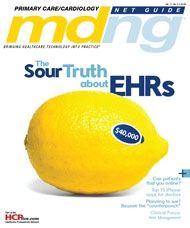Hurry Up and Wait
It's been three months since the passage of the American Recovery and Reinvestment Act of 2009, which incorporated the Health Information Technology for Economic and Clinical Health Act and its provision for billions of dollars in incentives to promote the use of interoperable, certified health information technologies.
It’s been three months since the passage of the American Recovery and Reinvestment Act of 2009 (ARRA), which incorporated the Health Information Technology for Economic and Clinical Health (HITECH) Act and its provision for billions of dollars in incentives to promote the use of interoperable, certified health information technologies. Although much is already known about the details surrounding this initiative—potential reimbursement timetables have been published, along with eligibility criteria for the Medicare and Medicaid portions of the programs—there is still much uncertainty over what qualifies as a “certified” EHR and how “meaningful use” of this technology will be defined. But, progress is being made every day.
Consensus seems to be forming around several factors that will define meaningful use: physicians will have to use EHRs to e-prescribe, coordinate care with other providers by exchanging patients’ clinical summaries and other data, and electronically document and report on quality metrics. ARRA established an HIT Standards Committee tasked with providing recommendations regarding certification criteria, implementations standards, and other issues. The committee has just begun the process of deliberation, testimony, and comment that will inform its decisions. John Halamka, MD, Chief Information Officer and Dean for Technology at Harvard Medical School, is also vice chair of the HIT Standards Committee. He published a recap of the first committee meeting at his website (http://geekdoctor.blogspot.com/2009/05/first-meeting-of-hit-standards.html). In addition to outlining what he refers to as the committee’s eight “guiding principles,” he also outlined several major themes that emerged during the meeting that will shape the debate going forward, and explained the standards adoption processes (the full implementation and operating plan is posted at www.hhs.gov/recovery/reports/plans/onc_hit.pdf).
I agree with Dr. Halamka that this document does a good job summarizing, as he puts it, “the magnitude of the work ahead” for the Office of the National Coordinator for Health Information Technology. He also states that “with each passing day, more and more details of the new plan are published at a remarkable pace.” That pace may not be fast enough, however, for physicians who are anxious to get started with the EHR selection and implementation process (which can take upwards of a year) but who are also worried that, in the absence of clear cut definitions for “certified EHR” and “meaningful use,” the system they purchase now may not meet the final eligibility requirements. With so many vendors claiming that they “know” what the meaningful use criteria will be, this anxiety is understandable. So I put it to our readers: Is there enough information currently available to make prospective EHR users reasonably certain that they can implement an HER secure in the belief that they will be eligible for the CMS incentive payments? Or is it wiser to take a wait-and-see approach, at least until the initial criteria are announced in December? Or, should the financial incentives not factor into this decision at all?
Thank you for reading.
Mike Hennessy
